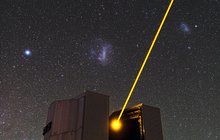4 Laser Guide Star Facility
Four new stars to defeat atmospheric turbulence
 April 2016 saw the arrival of four new stars above the Paranal skies. After years of development, ESO has completed the installation of the 4 Laser Guide Star Facility or 4LGSF, a new subsystem of the Adaptive Optics Facility (AOF) at the Very Large Telescope (VLT).
April 2016 saw the arrival of four new stars above the Paranal skies. After years of development, ESO has completed the installation of the 4 Laser Guide Star Facility or 4LGSF, a new subsystem of the Adaptive Optics Facility (AOF) at the Very Large Telescope (VLT).
The 4LGSF complements the Laser Guide Star Facility (LGSF). Instead of one laser, the 4LGSF sends four laser beams into the skies to produce four artificial stars by exciting sodium atoms located in the atmosphere at an altitude of 90 kilometres. Each laser delivers 22 watts of power — about 4000 times the maximum allowed for a laser pointer — in a beam with a diameter of 30 centimetres.
 Why is this new facility so important? This upgrade is necessary to support the new era of instruments at the Paranal Observatory, including HAWK-I (with GRAAL) and MUSE (with GALACSI). In comparison to the LGSF, the 4LGSF is more stable, and will require less preventative maintenance and preparation times for observing runs will be shorter. It will also be the best laboratory to test devices for the ELT, which will have a similar adaptive optics system. The LGSF will continue to support SINFONI, the instrument mounted at the Cassegrain focal station of UT4, as SINFONI was designed to work with only one laser, on the same axis of the telescope.
Why is this new facility so important? This upgrade is necessary to support the new era of instruments at the Paranal Observatory, including HAWK-I (with GRAAL) and MUSE (with GALACSI). In comparison to the LGSF, the 4LGSF is more stable, and will require less preventative maintenance and preparation times for observing runs will be shorter. It will also be the best laboratory to test devices for the ELT, which will have a similar adaptive optics system. The LGSF will continue to support SINFONI, the instrument mounted at the Cassegrain focal station of UT4, as SINFONI was designed to work with only one laser, on the same axis of the telescope.
So, how do the lasers help to correct the images? The biggest barrier between ground-based telescopes and the stars is the Earth’s atmosphere. Atmospheric turbulence causes a romantic but undesired effect in astronomy: twinkling stars, which result in blurred images.
Adaptive optics (AO) solves this problem by combining the latest technologies to correct for distortions introduced by the atmosphere. To do this, the AO system needs the light from a sufficiently bright star that is close to the target in the sky as a reference, and for many targets there are no suitable stars close by.
 And this is where the lasers come in. Lasers can excite sodium atoms in the mesosphere, which is located 90–110 kilometres above the Earth’s surface. The fluorescent light that is emitted by the sodium atoms and collected by the telescope is affected by the atmosphere in the same way as the light emitted by real stars is. So, the fluorescent light from the sodium atoms can be used by the adaptive optics system to measure and compensate for the distortions introduced by the atmosphere.
And this is where the lasers come in. Lasers can excite sodium atoms in the mesosphere, which is located 90–110 kilometres above the Earth’s surface. The fluorescent light that is emitted by the sodium atoms and collected by the telescope is affected by the atmosphere in the same way as the light emitted by real stars is. So, the fluorescent light from the sodium atoms can be used by the adaptive optics system to measure and compensate for the distortions introduced by the atmosphere.
ESO and several European institutes and industries, including TOPTICA, Germany; TNO, the Netherlands; MPB Communications, Canada; Optec, Italy; Astrel, Italy; and Laseroptik, Germany and INAF–Osservatorio di Roma, have made significant contributions to the project. The new 4LGSF is based on several new technologies. One of these is fibre Raman laser technology, which was developed by ESO and transferred to industry, resulting in a Raman fibre amplifier laser that is lighter, more rugged, and represents a breakthrough in size and stability.
All the operations at the 4LGSF will follow a protocol to avoid any risk to aircraft. The laser system is equipped with an automatic aircraft avoidance system that shuts down the lasers if an aircraft ventures too close to the beams.
